Blog
Ten thousand times
As I think about what’s important to me now, it’s all the things that give juice to my life. One of them is tai chi, the internal Chinese martial art. The correct term is t’ai chi ch’uan or taijiquan (supreme ultimate fist), but for simplicity I will use the more common term, tai chi.
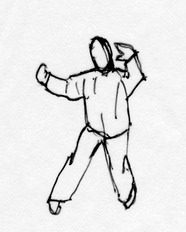
I’m so glad I rediscovered tai chi after failed attempts in the 80s and 90s. The first time around, I had visions of moving with effortless grace to the sounds of the wind rustling leaves and Zen-like music playing on a lute.
Sadly, that class was run on the “sink or swim” method. They threw you into the deep end and you were pretty much on your own. I quit.
Wind rustling leaves
To music played on a lute
Comes to screeching stop.
The second time around, I decided to try again, inspired by a news story about the benefits of tai chi for people with knee problems and arthritis. Arthroscopic surgery for a torn meniscus had left me with a bum knee. This time, I turned to instructional videos by tai chi Master T.Y. Pang. It worked well for a while, but pretty soon I gave up. I realized I couldn’t do it on my own.
Yet the meditative quality and the poetry of tai chi (who doesn’t want to move like a crane spreading its wings or with hands like clouds?) kept calling to me. I decided to give it one more try about a year and a half ago with twice-weekly classes at Windward Community College.
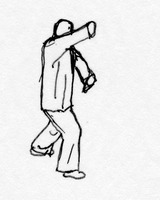
It’s the Dong form of the Yang style of tai chi as taught by some admirably dedicated teachers trained by our young master, Alex Dong. He developed his own style based on the tradition of a family lineage of tai chi masters dating back to his great grandfather, Tung (Dong) Ying Jie. Alex’s school had its beginning in Hawaii with the community college class, which he later relocated to New York City as the Alex Dong International Taijiquan Association.
In the beginning, I felt like I was setting myself up for failure – again – as I worried that the little grey cells were less sprightly, and they weren’t going to master tai chi anytime soon. After all, the more accomplished students have been doing tai chi for years – some for decades. I fretted that by getting such a late start I would never “get it.” A weekend workshop with Alex went a long way to helping me to persevere. He told me not to give up as one of his students is in her 80s and still making progress. Now, whenever I’m struggling with a set, I can hear his voice in my head. “Don’t worry. You’re doing fine.”
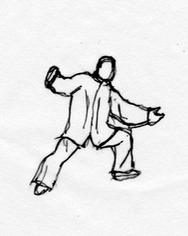
As a little background, our class concentrates on the slow form, which has three sections. By one count, the entire set has 81 movements – some with those poetic names I love, such as “Carry the tiger and return to the mountain,” ”Fair lady at the shuttle,” “Snake creeps down,” and “Embrace the peacock’s tail.”
The complete set done really slowly can take a good 40 minutes, non-stop. Try remembering all those movements while keeping your balance and form! I’ve learned to position myself so I’m surrounded by experienced people and cue off them as I move and turn in any direction.
Given this enormous challenge, you may wonder why I upped the ante by learning a new form – the Hao or hard form. It’s actually a little easier (relatively speaking) as it’s a variation of the slow form. I also like the energy of its thrusts and pushes and kicks, and its angular movements. I think it appeals to my metal dragon nature. I’m still feeling my way as we make our way through the movements.
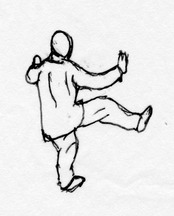
Kick with the right foot.
Turn and kick with the left foot.
Step up and punch. Hai!
Is it any wonder then that sometimes my frustration level threatens to spiral out of control, especially on those days when I feel like a klutz with a brain like a sieve? That’s when I remember the number: 10,000. To quote Alex in his book, Taijiquan Explained, “There is a saying in martial arts, ‘to master a form, you must practice at least ten thousand times.’” I did a quick calculation. I’ve been practicing an average of twice a week for 15 months, which works out to about 120 times. He also said, “If you practice anything ten thousand times, you will get very good at it. If you practice the slow form twice a day every day, that will take about fifteen years. If you only practice once a day, it will take twenty eight years.”
In another nifty little simile he said: “The depth of Taiji is like counting the hairs on a cow; in the time it take to finish counting the hairs you might be able to master Taijiquan.”
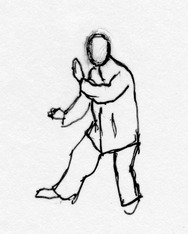
Looking at actuarial tables for a woman of my age and condition, I’m never going to make the 10,000 mark or count all those hairs. Aiya! Time to look at it another way. Tai chi is like meditation practice. You can either make yourself crazy with the frustration of not getting it right, or you can simply let go into the flow of the experience. When I manage to let go, and flow replaces performance anxiety, I find I can relax and sink into a place of calm – and even get some of the sequences right. I also think of a Buddhist saying, “Enlightenment is not being anxious about perfection.”
I’ll never be perfect, much less master the art of tai chi. So rather than worry about it, much better to enjoy the journey every step of the way.
Waving hands like clouds
Or grasping the swallow’s tail.
Tai chi poetry.

